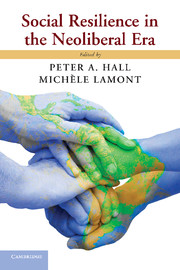Book contents
- Frontmatter
- Contents
- Contributors
- Foreword
- Prologue
- Acknowledgments
- Introduction
- Part I Neoliberalism
- Part II The Social Sources of Individual Resilience
- 4 Responses to Discrimination and Social Resilience Under Neoliberalism
- 5 Stigmatization, Neoliberalism, and Resilience
- 6 Security, Meaning, and the Home
- Part III Social Resilience on a Macro Scale
- PART IV Communities and Organizations as Sites for Social Resilience
- Index
- References
5 - Stigmatization, Neoliberalism, and Resilience
Published online by Cambridge University Press: 05 May 2013
- Frontmatter
- Contents
- Contributors
- Foreword
- Prologue
- Acknowledgments
- Introduction
- Part I Neoliberalism
- Part II The Social Sources of Individual Resilience
- 4 Responses to Discrimination and Social Resilience Under Neoliberalism
- 5 Stigmatization, Neoliberalism, and Resilience
- 6 Security, Meaning, and the Home
- Part III Social Resilience on a Macro Scale
- PART IV Communities and Organizations as Sites for Social Resilience
- Index
- References
Summary
This chapter applies the theories and tools of contemporary psychology to explore the relationship between neoliberalism understood as a set of values and socioeconomic conditions and various aspects of intergroup relations. My focus is on the sources and effects of prejudice or stigmatization and on the factors that confer resilience in the face of discrimination. There are significant puzzles here. Important contemporary social debates about immigration, racial equality, and aboriginal rights center on intergroup relations and such debates are now conditioned by neoliberal ideas (see Chapters 2 and 3). Does the prevalence of neoliberal beliefs increase the incidence of prejudice, as some suspect, or render it less likely by bringing meritocratic values to the fore (Becker 1957)? How might the popularity of neoliberal beliefs affect the resilience of people who experience discrimination? These are issues on which contemporary psychological research can shed light (e.g., Son Hing et al. 2011).
After considering the forms that prejudice can take, I begin by reviewing the changes in prejudice that have taken place during the neoliberal era. Second, drawing on literatures in psychology that associate prejudice with experiences of psychological threat, I explore how societal changes linked to neoliberal policies, practices, and narratives might have increased the incidence of prejudice. Finally, I review psychological research, including my own, that examines the relationship between attitudes that reflect prejudice and beliefs associated with neoliberalism.
- Type
- Chapter
- Information
- Social Resilience in the Neoliberal Era , pp. 158 - 182Publisher: Cambridge University PressPrint publication year: 2013
References
- 3
- Cited by



